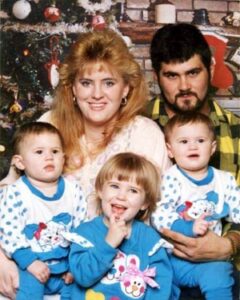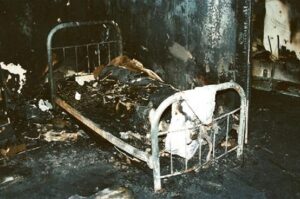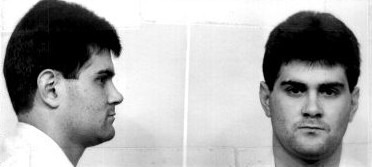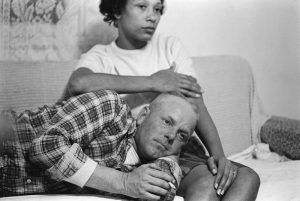Cameron Todd Willingham’s story is about a man who found himself caught in a never-ending cycle of injustice, flawed investigations, and an unpopular death penalty sentence. One dreadful day in 1991 caused Willingham’s life to change forever when a house fire took the lives of his three daughters, leading to his arrest for arson and murder.
A devastating house fire consumed the Corsicana, Texas, home of the Willingham family on December 23, 1991. Cameron Todd Willingham was at home with his three daughters: two-year-old twins, Karmon and Kameron, and one-year-old Amber.1

The fire was a horrific and chaotic event. Willingham managed to get out of the burning house through the flames and smoke, but he could not save his daughters. The deaths of the three girls caused the entire Corsicana community to be shaken with grief. A local bar threw a fundraiser to help with the cost of the children’s funerals. House fires in a small town like Corsicana were a big deal.2
In the aftermath of the fire, investigators worked to identify the cause of the incident. They quickly came to the conclusion that the fire was deliberately set and was classified as an arson-murder. Their search soon turned toward Cameron Todd Willingham.3
Authorities obtained evidence they believed implicated Willingham in the murders of his daughters as they attempted to piece together what had happened on that terrible day. The prosecution argued that Willingham had intentionally set the fire, leading to the deaths of Amber, Karmon, and Kameron.4

Willingham’s trial began in 1992; it was a painful experience for the grieving father. Presenting their case, the prosecution emphasized the conclusion of the fire investigators, who said the fire was intentionally set. Their main argument was that Willingham set the fire to cover up abuse allegations.5
Despite the efforts of his defense team, Willingham was found guilty of murder and arson. The jury quickly came to their conclusion in only 77 minutes. He received a death sentence that would ultimately seal his fate. Willingham was sent to the penitentiary in Huntsville, Texas. The institution was known to inmates as the “death pit.” The jury’s decision was based on what appeared to be compelling evidence at the time, but the true complexity of the case was yet to be revealed.6 In an interview with Elizabeth Gilbert, Willingham said, “What I’m guilty of is being a coward. I should’ve died in the house with my kids.”7
Many appeals were submitted, but they were all rejected. Willingham received a court order announcing “the Director of the Department of Criminal Justice at Huntsville, Texas, acting by and through the executioner designated by said Director… is hereby directed and commanded, at some hour after 6:00 p.m. on the 17th day of February, 2004, at the Department of Criminal Justice in Huntsville, Texas, to carry out this sentence of death by intravenous injection of a substance or substances in a lethal quantity sufficient to cause the death of said Cameron Todd Willingham.”8
After Willingham was convicted, questions regarding the reliability of the evidence used against him started to surface. The testimony of the fire investigators and their claim that the fire was started intentionally had been a major part of the case against him. It turned out that many of the arson investigators had only completed high school. To get certified, in most states, investigators have to complete a 40-hour course on fire investigation and pass a written test.9 However, as advancements in fire science and forensic analysis continued, questions arose about the methods and conclusions of the original arson investigation.
Experts in fire science and arson investigation began to reevaluate the case, raising significant concerns. Many of the methods and beliefs held by the original fire investigators were debunked by modern fire science. The misconceptions and outdated practices they relied upon became apparent. Contrary to the prosecution’s assertions, the physical evidence did not conclusively indicate arson. Modern fire investigators noted that there were no clear signs of accelerants, and the fire’s progression could be explained by natural causes. Witnesses who could have provided crucial evidence indicating an accidental fire, such as potential electrical issues in the house, were not adequately considered during the trial.10
As the doubts surrounding Willingham’s conviction mounted, a diverse group of individuals and organizations rallied behind his cause. Before his execution, Willingham said, “Please don’t ever stop fighting to vindicate me.”11 This made people more motivated to help Willingham’s case. Advocacy groups, legal experts, and fire investigators joined forces to argue that Willingham may have been wrongfully convicted. They contended that he had been unfairly judged based on outdated science and unreliable testimony. The battle for Willingham’s innocence took center stage as the legal system continued to move forward with his execution. Protests and public outrage increased, and Willingham himself maintained his innocence until the very end.
At the age of 36, Cameron Todd Willingham was executed by lethal injection on February 17, 2004. The day of his execution, the Texas Courts and Supreme Court refused to delay the execution. Governor Rick Perry denied Willingham a thirty-day stay of execution. Governor Rick Perry did not want to show mercy for criminals because he was running for reelection.12 In his last moments, he stood by his claim that he was innocent and that he was being executed for a crime he did not commit. His final words were, “The only statement that I want to make is that I’m an innocent man convicted of a crime I did not commit. I have been persecuted for twelve years for something I did not do. From God’s dust I came, and to dust I will return so the earth shall become my throne.”13 His case gained widespread coverage, raising the conversation about the death penalty and raising ethical concerns about putting to death someone whose guilt was far from certain.

Even after Willingham’s execution, the struggle to prove his innocence continued. A series of developments and revelations took place. Several experts in the fields of arson investigation and fire science testified in favor of the theory that Willingham may not have been properly convicted. The questionable evidence used against Willingham has drawn the attention of opponents of the death penalty, who believe his case may be the first to demonstrate that an innocent person was executed in the modern era of the death penalty.14 In 2008, the Willingham case was put under investigation by the Texas Forensic Science Commission. Their report, released in 2011, acknowledged the shortcomings of the original arson investigation and concluded that the methods used were “flawed.”15 The case became a divisive issue in Texas politics, with different governors and officials taking varying positions on Willingham’s guilt or innocence. It underscored the broader debate about the death penalty’s reliability and fairness.
On March 3, 2015, a press conference with death row exonerees was held on the Day of Innocence at the Texas Capital. After the conference, the exonerees spoke to State Senator Eddie Lucio Jr. to request that he file a first-time bill that would abolish the death penalty. On March 13, 2015, Senator Lucio filed a bill in the Texas Senate to abolish the death penalty completely. This was all due to Willingham being wrongfully accused.16
The Cameron Todd Willingham case raised a host of moral and ethical dilemmas. The controversy surrounding Willingham’s case sparked a new round of discussion over the death penalty’s irreversible consequences. Critics argue that the risk of executing an innocent person is too great, and Willingham’s case exemplified this risk. The case brought to light the possibility of faulty investigations, misleading expert testimony, and erroneous convictions, casting doubt on the judicial system’s general fairness and reliability. Willingham’s case served as a reminder of the importance of forensic science reform and modernization, as well as the significance of establishing convictions through solid scientific evidence.
Willingham’s family was also affected by the tragedy. They had to deal with the death of loved ones and with the knowledge that their father had been executed for a crime he did not commit. Stacy Kuykendall, Willingham’s wife, was greatly affected by this case because she lost both her husband and her three daughters to the court system and to the fire. The Willingham family experienced significant social, financial, and emotional effects from the case.
The case of Cameron Todd Willingham has left a lasting impact as an example of the possible injustices and flaws in the criminal justice system in the United States. Debates concerning the death penalty, erroneous convictions, and the requirement for criminal justice reform have resulted from it. His story serves as a reminder that the pursuit of justice should always be guided by truth, fairness, and the protection of innocent lives.
- RICHARD A. STACK and Benjamin Todd Jealous, “Cameron Todd Willingham,” in Grave Injustice, Unearthing Wrongful Executions (University of Nebraska Press, 2013), 42. ↵
- RICHARD A. STACK and Benjamin Todd Jealous, “Cameron Todd Willingham,” in Grave Injustice, Unearthing Wrongful Executions (University of Nebraska Press, 2013), 43. ↵
- David Grann, “Trial by Fire,” The New Yorker, August 31, 2009. ↵
- RICHARD A. STACK and Benjamin Todd Jealous, “Cameron Todd Willingham,” in Grave Injustice, Unearthing Wrongful Executions (University of Nebraska Press, 2013), 45. ↵
- RICHARD A. STACK and Benjamin Todd Jealous, “Cameron Todd Willingham,” in Grave Injustice, Unearthing Wrongful Executions (University of Nebraska Press, 2013), 46. ↵
- RICHARD A. STACK and Benjamin Todd Jealous, “Cameron Todd Willingham,” in Grave Injustice, Unearthing Wrongful Executions (University of Nebraska Press, 2013), 46-47. ↵
- RICHARD A. STACK and Benjamin Todd Jealous, “Cameron Todd Willingham,” in Grave Injustice, Unearthing Wrongful Executions (University of Nebraska Press, 2013), 51. ↵
- David Grann, “Trial by Fire,” The New Yorker, August 31, 2009. ↵
- David Grann, “Trial by Fire,” The New Yorker, August 31, 2009. ↵
- RICHARD A. STACK and Benjamin Todd Jealous, “Cameron Todd Willingham,” in Grave Injustice, Unearthing Wrongful Executions (University of Nebraska Press, 2013), 48-49. ↵
- “Cameron Todd Willingham – Innocent and Executed,” Cameron Todd Willingham: Innocent and Executed (website), accessed November 24, 2023, http://camerontoddwillingham.com/. ↵
- RICHARD A. STACK and Benjamin Todd Jealous, “Cameron Todd Willingham,” in Grave Injustice, Unearthing Wrongful Executions (University of Nebraska Press, 2013), 54. ↵
- RICHARD A. STACK and Benjamin Todd Jealous, “Cameron Todd Willingham,” in Grave Injustice, Unearthing Wrongful Executions (University of Nebraska Press, 2013), 41. ↵
- Maurice Possley, “The Prosecutor and the Snitch,” The Marshall Project, August 3, 2014. ↵
- “Cameron Todd Willingham: Wrongfully Convicted and Executed in Texas,” Innocence Project (website), accessed November 24, 2023, https://innocenceproject.org/cameron-todd-willingham-wrongfully-convicted-and-executed-in-texas/. ↵
- “Cameron Todd Willingham – Innocent and Executed,” Cameron Todd Willingham: Innocent and Executed (website), accessed November 24, 2023, http://camerontoddwillingham.com/. ↵



3 comments
Natalia De La Garza
Your draft is a compelling and empathetic account of Cameron Todd Willingham’s tragic case
LEE
This is such a interesting article about the man Cameron Todd Willingham described as the tragic journey of a wrongfully convicted man.This topic is interesting and scary at the same time. But i really enjoyed reading it. Thank you for sharing such a wonderful story for us to read. I want to share this with my friends to know what happen to this man. Thank you
Lizette Sanabria
Excellent article! You are very thorough in your work.